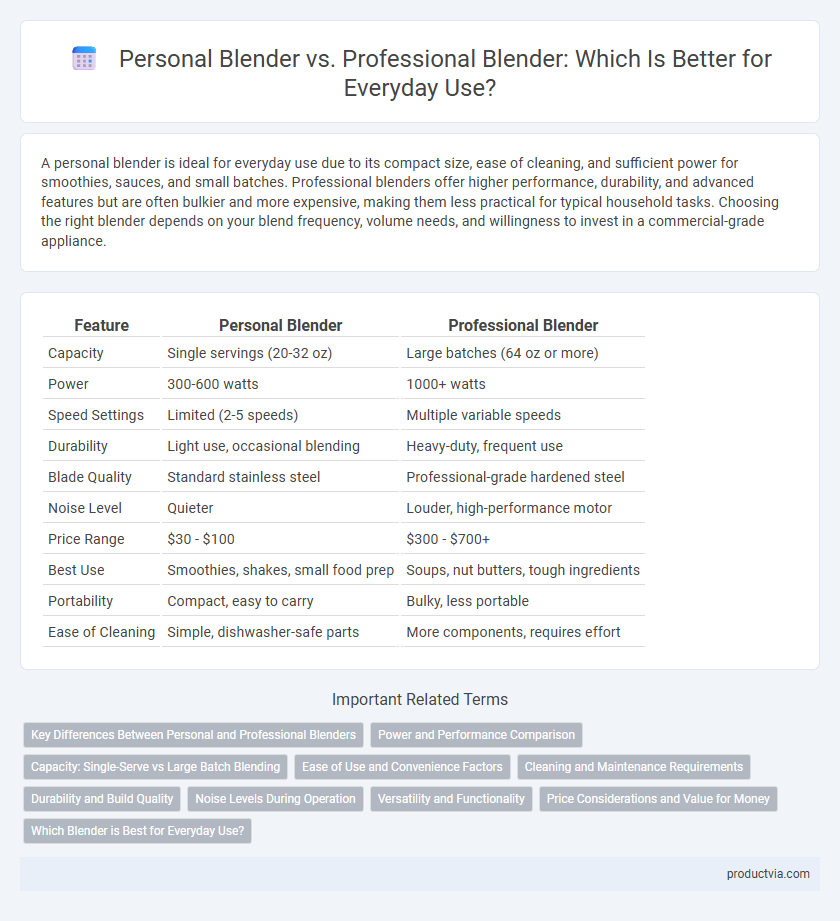A personal blender is ideal for everyday use due to its compact size, ease of cleaning, and sufficient power for smoothies, sauces, and small batches. Professional blenders offer higher performance, durability, and advanced features but are often bulkier and more expensive, making them less practical for typical household tasks. Choosing the right blender depends on your blend frequency, volume needs, and willingness to invest in a commercial-grade appliance.
Table of Comparison
| Feature | Personal Blender | Professional Blender |
|---|---|---|
| Capacity | Single servings (20-32 oz) | Large batches (64 oz or more) |
| Power | 300-600 watts | 1000+ watts |
| Speed Settings | Limited (2-5 speeds) | Multiple variable speeds |
| Durability | Light use, occasional blending | Heavy-duty, frequent use |
| Blade Quality | Standard stainless steel | Professional-grade hardened steel |
| Noise Level | Quieter | Louder, high-performance motor |
| Price Range | $30 - $100 | $300 - $700+ |
| Best Use | Smoothies, shakes, small food prep | Soups, nut butters, tough ingredients |
| Portability | Compact, easy to carry | Bulky, less portable |
| Ease of Cleaning | Simple, dishwasher-safe parts | More components, requires effort |
Key Differences Between Personal and Professional Blenders
Personal blenders typically feature compact designs with single-serve capacities up to 32 ounces, optimized for quick smoothies and small batches, while professional blenders offer larger jars exceeding 64 ounces suitable for bulk preparation. Motor power differs significantly, with personal blenders ranging from 200 to 600 watts, delivering sufficient power for light tasks, compared to professional blenders boasting 1000 watts or more for handling tough ingredients and continuous heavy-duty use. The construction materials and durability also vary; professional blenders often incorporate metal components and vibration-resistant bases for enhanced longevity, whereas personal blenders prioritize portability and ease of cleaning with lightweight plastics.
Power and Performance Comparison
Personal blenders typically feature motors ranging from 200 to 600 watts, suitable for simple tasks like smoothies and light blending but may struggle with tougher ingredients or larger batches. Professional blenders often exceed 1000 watts, delivering higher torque and consistent performance ideal for heavy-duty blending, nut butters, and frequent use in commercial or serious home settings. Evaluating power and performance differences ensures selecting the right blender matches everyday needs and ingredient toughness without overpaying for unnecessary features.
Capacity: Single-Serve vs Large Batch Blending
Personal blenders typically offer a single-serve capacity ranging from 16 to 32 ounces, ideal for quick smoothies or small portions, while professional blenders provide large batch blending capabilities of 64 ounces or more, suitable for families or meal prepping. The choice depends on daily blending volume and space constraints, with personal blenders being compact and easy to clean, contrasted by professional models that deliver powerful motors and durable construction for frequent, heavy use. Selecting the appropriate blender capacity enhances convenience and efficiency in everyday kitchen tasks.
Ease of Use and Convenience Factors
Personal blenders excel in ease of use with simple one-touch operations and compact designs ideal for quick smoothies and small batches. Professional blenders offer advanced speed settings and more durable components but often require more effort to clean and store. For everyday use, personal blenders provide greater convenience and faster cleanup, making them perfect for busy lifestyles.
Cleaning and Maintenance Requirements
Personal blenders typically feature fewer components and simpler designs, making cleaning and maintenance quicker and easier for everyday use. Professional blenders often have detachable blades and more parts to clean, requiring more time and effort to maintain optimal performance. Choosing a blender with dishwasher-safe parts and accessible crevices can significantly reduce daily cleaning tasks.
Durability and Build Quality
Professional blenders typically offer superior durability and build quality compared to personal blenders due to higher-grade materials like stainless steel blades and reinforced motor housings. Personal blenders are designed for convenience and portability but often feature less robust components that may wear out faster under frequent use. Choosing a blender with a metal drive coupling and a powerful, well-ventilated motor extends longevity, especially for everyday blending tasks.
Noise Levels During Operation
Personal blenders typically generate lower noise levels, ranging from 60 to 70 decibels, making them suitable for quiet environments and everyday use. Professional blenders often operate between 80 and 90 decibels, which can be disruptive in home settings but necessary for heavy-duty blending tasks. Noise insulation features and motor power directly influence operational sound intensity, affecting user comfort during frequent blending sessions.
Versatility and Functionality
Personal blenders offer compact design and ease of use, ideal for smoothies, shakes, and small food prep tasks, emphasizing portability and quick cleaning. Professional blenders provide higher power, durability, and advanced settings, suitable for diverse recipes including soups, nut butters, and dough, enhancing versatility in everyday kitchen use. Choosing between them depends on the balance of frequent blending tasks, desired consistency, and long-term performance needs.
Price Considerations and Value for Money
Personal blenders typically range from $30 to $100, offering compact size and convenience suitable for daily smoothies and small batches, while professional blenders, priced between $200 and $600, provide superior power, durability, and versatility for frequent heavy-duty blending. Evaluating value for money involves balancing budget constraints with desired performance features such as motor wattage, blade quality, and capacity tailored to everyday kitchen tasks. Investing in a professional blender may yield long-term savings through enhanced lifespan and efficiency, despite a higher upfront price compared to economical personal blenders.
Which Blender is Best for Everyday Use?
Personal blenders like the NutriBullet and Magic Bullet offer compact size, ease of cleaning, and sufficient power for smoothies, making them ideal for quick, everyday use. Professional blenders such as Vitamix or Blendtec provide higher wattage, durable construction, and versatile functions, ensuring smoother blends and the ability to handle tougher ingredients but at a higher price and larger footprint. For everyday use, personal blenders strike the best balance between convenience, affordability, and performance for most users.
Personal blender vs professional blender for everyday use Infographic

 productvia.com
productvia.com